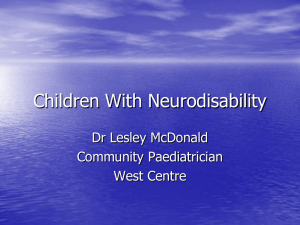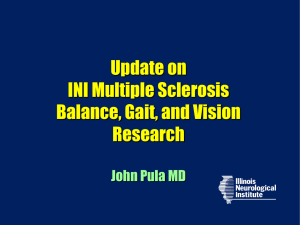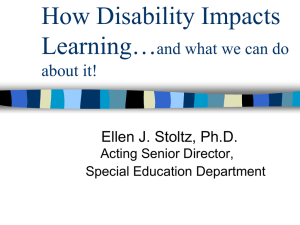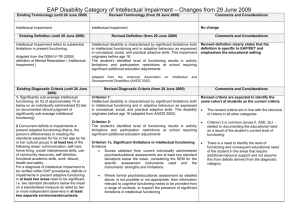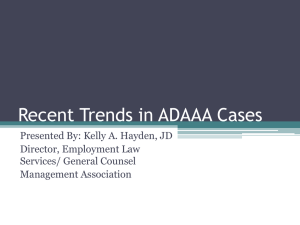Role of LD Psychologist - Dr Alex Clark
advertisement
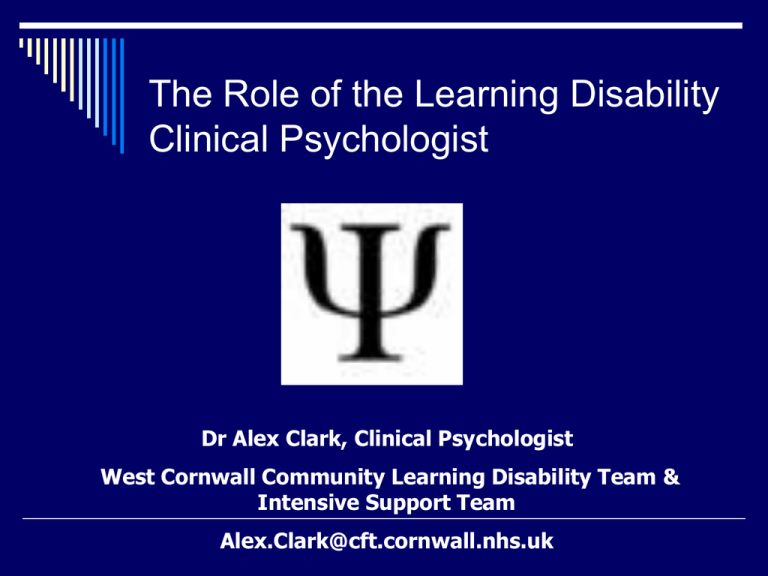
The Role of the Learning Disability Clinical Psychologist Dr Alex Clark, Clinical Psychologist West Cornwall Community Learning Disability Team & Intensive Support Team Alex.Clark@cft.cornwall.nhs.uk Aspects of the Role Assessment Formulation Intervention - Service Users - Staff - The MDT Consultation & Training Service Development Assessment What is a Learning Disability? & Eligibility assessments (NOT just an IQ score!) Functional Behavioural Analysis – observations, ABCs, interviewing - supervision and training Specialist Assessment e.g. capacity/risk assessment (violence/sexual offending)/parenting. Psychological assessment – e.g. neuropsychological, systemic, attachment/relational history. Historical Context to Learning Disability Many terms been used over the last 200 years (idiocy, feeblemindedness, mental deficiency, mental disability, mental handicap, mental subnormality, mental retardation) Now: UK: Learning Disability US: Intellectual Disability World Health Organisation and American Psychiatric Association definition of Learning Disability There are three core criteria: Significant impairment of intellectual functioning Significant impairment of adaptive/social functioning Age of onset is before adulthood Process of Learning Disability Assessment Referral Clinical Interview Consent Ethical considerations including current context Background information Biological, psychological and social contexts Psychometric Assessment (order decided by the person) Adaptive Behaviour Assessment System 2nd Edition Weschler Adult Intelligence Scale- 4th edition (new) Report or letter written ideally with the client as the primary audience but considerations around other audience members. Defining ‘Significant Impairment’ Both Intelligence and Adaptive/Social functioning have standardised measures, with a mean of 100 and 1 standard deviation of 15 Significant impairment = 2 standard deviations from the mean which equates to 70 or less, the lowest 2.2% of the general population Working backwards this would mean that between 2% of the population have a learning disability, actually worked out as 2-3% of population 100 70 85 115 130 Y axis (% of population) 2% 14% 34% 34% 14% 2% X axis (Scores) WAIS - IVUK 13 subtests assessing different aspects of the construct of ‘Intelligence’ Scores then compared with a general population providing: Full Scale IQ Verbal Comprehension Index Perceptual Organisation Index Working Memory Index Processing Speed Index Significant impairment of adaptive/social functioning Definition of adaptive/social functioning relates to a person’s performance in coping on a day to day basis with the demands of their environment American Association on Mental Retardation (1992) further defined as impairments in at least two of the following: Communication Community Use Self care Functional Academics Home living Work (if in a job) Social Skills Leisure Health and Safety Self direction Adaptive Behaviour Assessment System (ABAS II) Scores then compared with a general population providing: General Adaptive Composite (GAC) Conceptual Composite (Communication, Functional Academics, Self Direction) Social Composite (Leisure, Social) Practical Composite (Community Use, Home Living, Health and Safety, Self Care, Work) Significant Impairment is: a GAC of <70, one of the other Composite scores <70, or significant difficulty in 3 or more of the specific skill areas Age of Onset It is important that any significant impairments of intellectual and adaptive/social functioning occur before adulthood Thus forming part of a developmental process (i.e. developmental disability) General consensus is that this is before the person turns 18 years old Therefore important that a developmental history be taken to provide context, including: Birth and pre birth information Developmental milestones and concerns about not achieving milestones Childhood diagnoses / illnesses School experiences / Statement of Educational Need Changes in ability during adulthood due to other events (e.g. head injury, dementia, mental health problems, reactions to medication etc) Formulation The 4 P’s –Predisposing, Precipitating, Perpetuating, Protective factors Models of formulation – psychodynamic (Malan), systemic, CBT Consulting to the system re: formulation Intervention for Service UsersAims of psychotherapy The therapeutic relationship – establishing, maintaining and repairing Meaning making – offering an explanatory framework/narrative to help the client make sense of their difficulties Change promotion – acquiring new skills and trying them out in therapy and real life (e.g. how to repair relationship, experiencing oneself as different) Intervention – Service Users Cognitive Behavioural - thoughts, feelings, behaviour, beliefs and schemas (Stenfert Kroese, Dagnan, Willner) Psychoanalytic – unconscious, transference, tactical defences, object relations (Beail, Sinason, Frankish) Attachment – security and safety, exploration, internal working models, loss & separation (Holmes) Systemic/Family Therapy – circularity, curiosity, homeostasis, family life cycle (Baum) Social Constructionist – inequality, social structures, community psychology Adaptations of Psychotherapy for people with Learning Disabilities Pre-assessment re: cognitive level of understanding, TBF assessment (Reed & Clements), emotional awareness, labelling of emotions Language use - person centred approach Use of visual supports (photos, pictures, signing, availability of materials) Level of directiveness (e.g. ASD) Negotiation re: others’ presence Communication with systems (family, staff teams) Interventions-Staff Team Formulation-co-construction and discussion Training and consultation re: behavioural assessment/care planning/interventions (e.g. ASD & communication) Systemic working to encourage team’s reflection around relationships with service user(s) and conflicts, considering emotional needs of staff Interventions-The MDT Reflective Practice sessions – “stuck” situations, team difficulties, emotional support MDT meetings - encouraging reflection on service users’ relational and psychological context in considering mood and behaviour Consultation role Any questions?



